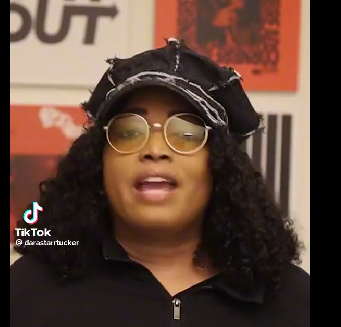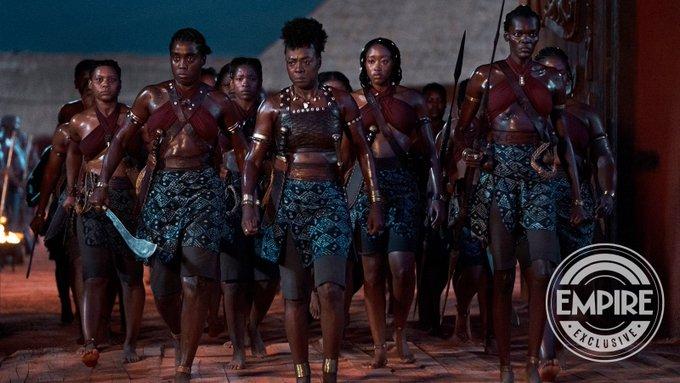-
Posts
2,407 -
Joined
-
Last visited
-
Days Won
91
Content Type
Profiles
Forums
Blogs
Events
Status Updates posted by richardmurray
-
May mermay's from GDBEE
GOLDFISH
LITTLE SUNFISH

PINK AND TEAL

URSULA
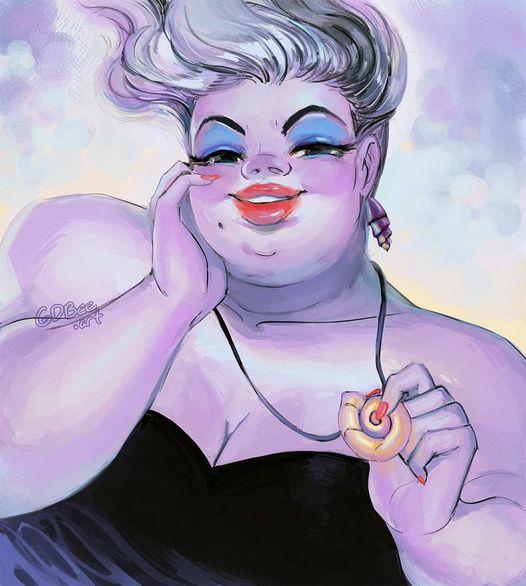
Artist: GDBee < https://gdbee.store/ >
prior entry
https://aalbc.com/tc/profile/6477-richardmurray/?status=1913&type=status
GDBee entries
https://aalbc.com/tc/search/?q=gdbee&quick=1&type=core_statuses_status -

Got questions for the Ms. Marvel cast and filmmakers? They have answers! Submit questions here, and tune in on June 7th at 12pm PT/3pm ET for their Answer Time.
https://marvelstudios.tumblr.com/post/685889428738228224/got-questions-for-the-ms-marvel-cast-and -
When a person is feeling negative, from a bad mood to hate, the reasons why are not a straight line. It depends on many things. And, the choices said person has to emit their negativity are near infinite, with many versions involving harming others, from slightest injury to murder.
But, I know that any of my enslaved forebears didn't need a weapon to want to kill white people. And I know that the weapon of choice from the anarchist or the Irish republican army wasn't a gun but an explosive, which can be made by anyone in the usa.
So, I will not go into any detail on my thoughts to who is to blame. But I know that whatever plus whomever is to blame will not lead to the answer of the following question.
How does a populace of mostly unhappy people , from the native american since before the usa was founded to the most recent immigrants under a bridge, survive peacefully?
-
In this very community I stated and state that one of the problems the Black populace in the USA has is the lack of one attempted idea in its history?
Do you know what that is?
No it isn't starting businesses. It isn't going to ivy league schools or historical black colleges. It isn't becoming elected officials. It isn't joining the USA military or a local law enforcement. It isn't having many lawyers or doctors or business owners.
The Black populace in the USA has financially tried everything, as individuals or groups.
The Black populace in the USA has governmentally not tried everything, as individuals or groups.
Yes, Black populace has many independent voters, people who vote based on candidate agenda, in the voting stream.
The one major absence in the Black populace historically or modernly is a Black Party to Governance. I rephrase, the Black populace in the USA has never had a rival to the Republicans or Democrats solely for the Black populaces benefit.Now, why is that? The answer is long winded , a long history, but simple in function. From the Black minority that fought with the colonists against the British <the Black majority were enslaved> to Frederick Douglass who publicly opposed Haiti, leaving the usa, or Black segregation from whites to former president Barack Obama. Many, usually most in history, Black leaders in the USA support a positive phenotypical integration to Whites.
A Black party of governance by default is segregatory in nature. Sequentially, that is why it has not been attempted with the vigor of Black business communities in white cities or Black membership in the US military or other ventures, all of which demand positive integration with whites at their heart to work
But, a white man in the article given in total below, states a simple truth.
The USA government has a need to be restructured that goes beyond a law being passed. He doesn't suggest a new party of governance is the answer. He suggest the answer is a change in the membership of the donkeys or the elephants. A membership change with those willing to be effective over alliances in public or private or to institutional structures.
But I argue, from the NAtive American populace to the Black populace < descended of enslaved plus not descended from enslaved> each peoples of color in the USA <non white europeans> have specific needs that can not be handled by one party of governance.
I restate, in the USA no one party can help everybody. Every party of governance has to fail somebody.
Thus, Black people in the USA don't need to be an option, they need to be the purpose.ARTICLE
EZRA KLEIN
What America Needs Is a Liberalism That Builds
May 29, 2022Early in Joe Biden’s presidency, Felicia Wong, the president of the liberal Roosevelt Institute, told me < https://www.nytimes.com/2021/09/03/podcasts/transcript-ezra-klein-interviews-felicia-wong.html > that Biden was badly misunderstood. He’s been in national politics for decades, and so people look at him and “default to a kind of old understanding of what Democrats stand for, this idea that Democrats are tax-and-spend liberals.” Wong thought he wanted more: “What Biden is trying to push is much more about actually remaking our economy, so that it does different things and it actually regularly produces different outcomes.”
I think Wong was right about what Biden, or at least the Biden administration, wanted. But its execution has lagged its vision. And the reason for this is uncomfortable for Democrats. You can’t transform the economy without first transforming the government.
In April, Brian Deese, the director of Biden’s National Economic Council, gave an important speech on the need for “a modern American industrial strategy.” This was a salvo in a debate most Americans would probably be puzzled to know Democrats are having. Industrial strategy is the idea that a country should chart a path to productive capacity beyond what the market would, on its own, support. It is the belief that there should be some politics in our economics, some vision of what we are trying to make beyond what financial markets reward.
Trying to build clean energy infrastructure is a form of industrial strategy. So is investing in domestic supply chains for vaccines and masks and microchips. For decades, the idea has been disreputable, even among Democrats. You don’t want government picking winners and losers, as the adage goes.
The argument, basically, is this: When governments bet on technologies or companies, they typically bet wrong. Markets are more efficient, more adaptable, less corrupt. And so governments should, where possible, get out of the market’s way. The government’s proper role is after the market has done its work, shifting money from those who have it to those who need it. Put simply, markets create, governments tax, and politicians spend.
It’s remarkable, the assumptions that lurk beneath what’s taken for common sense in Washington. Consider the phrase “winners and losers.” Winners at what? Losers how? Markets manage such questions through profits and losses, valuations and bankruptcies. But societies have richer, more complex goals. To criticize markets for failing to achieve them is like berating a toaster because it never produces an oil painting. That’s not its job.
So I won’t say markets failed. We failed. Growth slowed, inequality widened, the climate crisis kept getting worse, deindustrialization wrecked communities, the pandemic proved America’s supply chains fragile, China became more authoritarian rather than more democratic, and then Vladimir Putin’s war revealed the folly of relying on countries we cannot trust for goods we desperately need.
No one considers this success. Deese, in his speech to the Economic Club of New York., declared the debate over: “The question should move from ‘Why should we pursue an industrial strategy?’ to ‘How do we pursue one successfully?’”
I am unabashedly sympathetic to this vision. In a series of columns over the past year < https://www.nytimes.com/2021/09/19/opinion/supply-side-progressivism.html , https://www.nytimes.com/2022/02/12/opinion/yellen-supply-side-liberalism.html , https://www.nytimes.com/2022/03/13/opinion/berkeley-enrollment-climate-crisis.html , https://www.nytimes.com/2022/01/16/opinion/biden-obama-economy.html > , I’ve argued that we need a liberalism that builds. Scratch the failures of modern Democratic governance, particularly in blue states, and you’ll typically find that the market didn’t provide what we needed and government either didn’t step in or made the problem worse through neglect or overregulation.
We need to build more homes, trains, clean energy, research centers, disease surveillance. And we need to do it faster and cheaper. At the national level, much can be blamed on Republican obstruction and the filibuster. But that’s not always true in New York or California or Oregon. It is too slow and too costly to build even where Republicans are weak — perhaps especially where they are weak.
This is where the liberal vision too often averts its gaze. If anything, the critiques made of public action a generation ago have more force today. Do we have a government capable of building? The answer, too often, is no. What we have is a government that is extremely good at making building difficult.
The first step is admitting you have a problem, and Deese, to his credit, did exactly that. “A modern American industrial strategy needs to demonstrate that America can build — fast, as we’ve done before, and fairly, as we’ve sometimes failed to do,” he said.
He noted that the Empire State Building was constructed in just over a year. We are richer than we were then, and our technology far outpaces what was available in 1930. And yet does anyone seriously believe such a project would take a year today?
“We need to unpack the many constraints that cause America to lag other major countries — including those with strong labor, environmental and historical protections — in delivering infrastructure on budget and on time,” Deese continued.
One answer — the typical Republican answer — is that government can’t do the job and shouldn’t try. But the data doesn’t bear that out. The Transit Costs Project tracks < https://transitcosts.com/what-does-the-data-say/ > the price tags on rail projects in different countries. It’s hard to get an apples-to-apples comparison here, because different projects are, well, different, and it matters whether they include, say, a tunnel, which is expensive for all the obvious reasons.
Even so, the United States is notable for how much we spend and how little we get. It costs about $538 million to build a kilometer (about 0.6 mile) of rail here. Germany builds a kilometer of rail for $287 million. Canada gets it done for $254 million. Japan clocks in at $170 million. Spain is the cheapest country in the database, at $80 million. All those countries build more tunnels than we do, perhaps because they retain the confidence to regularly try. The better you are at building infrastructure, the more ambitious you can be when imagining infrastructure to build.
The problem isn’t government. It’s our government. Nor is the problem unions — another favored bugaboo of the right. Union density is higher in all those countries than it is in the United States. So what has gone wrong here?
One answer worth wrestling with was offered by Brink Lindsey, the director of the Open Society Project at the Niskanen Center, in a 2021 paper < https://www.niskanencenter.org/state-capacity-what-is-it-how-we-lost-it-and-how-to-get-it-back/ > titled “State Capacity: What Is It, How We Lost It, and How to Get It Back.” His definition is admirably terse. “State capacity is the ability to design and execute policy effectively,” he told me. When a government can’t collect the taxes it’s owed or build the sign-up portal for its new health insurance plan or construct the high-speed rail it’s already spent billions of dollars on, that’s a failure of state capacity.
But a weak government is often an end, not an accident. Lindsey’s argument is that to fix state capacity in America, we need to see that the hobbled state we have is a choice and there are reasons it was chosen. Government isn’t intrinsically inefficient. It has been made inefficient. And not just by the right:
Highlight : What is needed most is a change in ideas: namely, a reversal of those intellectual trends of the past 50 years or so that have brought us to the current pass. On the right, this means abandoning the knee-jerk anti-statism of recent decades; embracing the legitimacy of a large, complex welfare and regulatory state; and recognizing the vital role played by the nation’s public servants (not just the police and military). On the left, it means reconsidering the decentralized, legalistic model of governance that has guided progressive-led state expansion since the 1960s; reducing the veto power that activist groups exercise in the courts; and shifting the focus of policy design from ensuring that power is subject to progressive checks to ensuring that power can actually be exercised effectively.
The Biden administration can’t do much about the right’s hostility to government. But it can confront the mistakes and divisions on the left.
A place to start is offered in another Niskanen paper, this one by Nicholas Bagley, a law professor at the University of Michigan. In “The Procedure Fetish” < https://www.niskanencenter.org/the-procedure-fetish/ > he argues that liberal governance has developed a puzzling preference for legitimating government action through processes rather than outcomes. He suggests, provocatively, that that’s because American politics in general and the Democratic Party, in particular, are dominated by lawyers. Biden and Kamala Harris hold law degrees, as did Barack Obama and John Kerry and Bill and Hillary Clinton before them. And this filters down through the party. “Lawyers, not managers, have assumed primary responsibility for shaping administrative law in the United States,” Bagley writes. “And if all you’ve got is a lawyer, everything looks like a procedural problem.”
This is a way that America differs from peer countries: Robert Kagan, a law professor at the University of California, Berkeley, has called this “adversarial legalism” and shown that it’s a distinctively American way of checking state power. Bagley builds on this argument. “Inflexible procedural rules are a hallmark of the American state,” he writes. “The ubiquity of court challenges, the artificial rigors of notice-and-comment rule making, zealous environmental review, pre-enforcement review of agency rules, picayune legal rules governing hiring and procurement, nationwide court injunctions — the list goes on and on.”
The justification for these policies is that they make state action more legitimate by ensuring that dissenting voices are heard. But they also, over time, render government ineffective, and that cost is rarely weighed. This gets to Bagley’s ultimate and, in my view, wisest point. “Legitimacy is not solely, not even primarily, a product of the procedures that agencies follow,” he says. “Legitimacy arises more generally from the perception that government is capable, informed, prompt, responsive and fair.” That is what we’ve lost — in fact, not just in perception.
Rebuilding that kind of government isn’t a question of regulatory tweaks and interagency coordination. It’s difficult, coalition-splitting work. It pits Democratic leaders against their own allies, against organizations and institutions they’ve admired or joined against processes whose justifications they’ve long ago accepted and laws they consider jewels of their past.
The environmental movement cheers when Biden says he wants to decarbonize and fast. But if he said that in order to achieve that goal, he wanted to reform or waive large sections of the National Environmental Policy Act to speed the construction of clean energy infrastructure, he’d find himself at war. What if he decided to argue not just that government workers should be paid more but also that they should be easier to both hire and fire?
I’ve spent most of my adult life trawling think tank reports to better understand how to solve problems. When I go looking for ideas on how to build state capacity on the left, I don’t find much. There’s nothing like the depth of research, thought and energy that goes into imagining health and climate and education policy. But those health, climate and education plans depend, crucially, on a state capable of designing and executing policy effectively. This is true at the federal level, and it is even truer, and harder, at the state and local levels.
So this is what I have become certain of: Democrats spend too much time and energy imagining the policies that a capable government could execute and not nearly enough time imagining how to make a government capable of executing them. It is not only markets that have failed.
https://www.nytimes.com/2022/05/29/opinion/biden-liberalism-infrastructure-building.html
-

FEETORFIN
NANEDUD
Nanedud
https://www.deviantart.com/hddeviant/art/Nanedud-feetorfins-917368124\Storyboard film
https://richardmurrayhumblr.tumblr.com/post/685389008049700864/this-is-the-storyboard-film-describing-how-theTutorial page
https://www.deviantart.com/hddeviant/status-update/Here-is-a-tutorial-for-917387444Nanedud Tutorial PArt 1
image
https://www.deviantart.com/hddeviant/art/Nanedud-Tutorial-Part-1-917385464
audio
https://richardmurrayhumblr.tumblr.com/post/685389510706610176/this-is-part-1-of-the-audio-tutorial-for-my
Nanedud Tutorial Part 2
image
https://www.deviantart.com/hddeviant/art/Nanedud-Tutorial-Part-2-917385896
audio
https://richardmurrayhumblr.tumblr.com/post/685389892887429120/this-is-part-2-of-the-audio-tutorial-for-my
Nanedud Tutorial Part 3
image
https://www.deviantart.com/hddeviant/art/Nanedud-Tutorial-Part-3-917386210
audio
https://richardmurrayhumblr.tumblr.com/post/685390159525609472/this-is-part-3-of-the-audio-tutorial-for-my
Nanedud Tutorial Part 4
image
https://www.deviantart.com/hddeviant/art/Nanedud-Tutorial-Part-4-917386355
audio
https://richardmurrayhumblr.tumblr.com/post/685390358842146816/this-is-part-4-of-the-audio-tutorial-for-my
Nanedud Tutorial Part 5
image
https://www.deviantart.com/hddeviant/art/Nanedud-Tutorial-Part-5-917386513
audio
https://richardmurrayhumblr.tumblr.com/post/685390595415572480/this-is-part-5-of-the-audio-tutorial-for-myAnayena in color
https://www.deviantart.com/hddeviant/art/Anayena-feet-or-fin-917367708Comic Gif
https://www.deviantart.com/hddeviant/art/Anayena-gif-v3-917393587Edition 2 of "The End Of Series" pages
Page 1
https://www.deviantart.com/hddeviant/art/Anayena-page-1-917389663
Page 2
https://www.deviantart.com/hddeviant/art/Anayena-page-2-917389854
Page 3
https://www.deviantart.com/hddeviant/art/Anayena-page-3-917389960
Page 4
https://www.deviantart.com/hddeviant/art/Anayena-page-4-917390047
Page 5
https://www.deviantart.com/hddeviant/art/Anayena-page-5-917390115
Page 6
https://www.deviantart.com/hddeviant/art/Anayena-page-6-917390231
Page 7
https://www.deviantart.com/hddeviant/art/Anayena-page-7-917390311
Page 8
https://www.deviantart.com/hddeviant/art/Anayena-page-8-917390402
Page 9
https://www.deviantart.com/hddeviant/art/Anayena-page-9-917390472
Page 10
https://www.deviantart.com/hddeviant/art/Anayena-page-10-917390530
Page 11
https://www.deviantart.com/hddeviant/art/Anayena-page-11-917390601 -
@darastarrtucker #sesamestreet #joanganzcooney #jonstone #lloydmorrisett #racialsegregation #childrenstelevision #childrenstelevisionworkshop #muppets #publictelevision #publictv #pbs #ctw #earlychildhoodeducation #educationaltv @darastarrtucker ♬ original sound - Dara Starr Tucker i love how she never said white, she said middle class as compared to black and brown kids. I didn't realize financial middle class is comparable to black or brown which are phenotype. She mentions the colleges of these people. yes, people know each other based on their circles. yes. IT doesn't mean being in that circle is a positive. ... The point that the producers and creators all realized they didn't need to say what they were clearly doing is an interesting point. today, everything must be announced. Maybe sesamae street had a better media position than in modernity. and sesame street is still controversial. PEople today don't seem to realize that all art is always somewhere controversial. the question is, does that controversial status make it banned or blocked or financially influenced in a deadly way.
https://www.tiktok.com/@darastarrtucker/video/7095684407448653099
in amendment
The point I concur to her most that she made in the post is about how the original creators of sesame street didn't constantly proclaim they accepted phenotypical integration. They simply enacted it. I think a lesson to many pro-miscegenist or integrationists can be learned from the sesame originators. You don't have to wave a flag for a cause you are supporting. Just simply act it. It can be argued, all groups in the usa need to learn that but I comgress.... the point I concur least is that sesame street isn't controversial today. It is. All art is always controversial somewhere, to some people. The question is, do those people's controversions to said art have the ability to restrict/end/financially lead to death the art, ala the Nat King Cole show. The Nat King Cole show, even white media admits, was getting more viewers, but the condemnations of whites in the south was too large/valuable to treat the nat king cole show with the respect a show getting the highest ratings in a fiscal capitalistic country , on financial merit warrant.
in amendment
did you know ? The lesson we writers can take from the creators of sesame street is , whatever our philosophies, let the art do the talking when asked what culture our art signifies. -
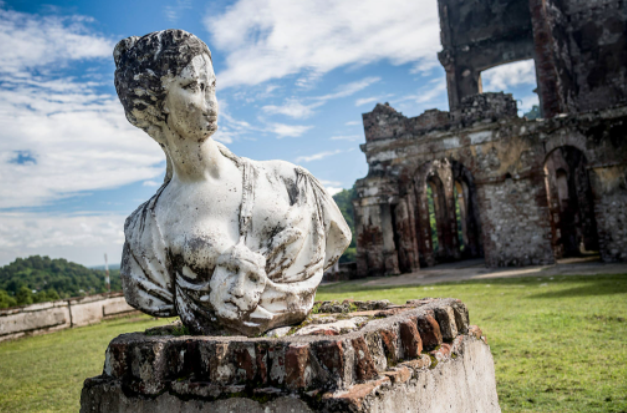
The key in the recent publicity to Haiti is that, France didn't force Haiti or trick haiti. WHy?
Haiiti had great leadership between toussaint louverture-jean jacques dessalines-henri christophe, but after henri christophe died, the quality in leadership went down and when one country surrounds another with an army, the test of community is at one of its highest. Individuals doing for themselves will not be enough , and not everyone will be strong so you need leadership. Absent leadership you sign agreements with hostiles.
Yamiche Alcindor tweeted
https://twitter.com/Yamiche/status/1528112267505684480
My reply
haiti was not forced to pay france anything. the great leaders of the revolution were all dead and those who left were weak. LEaderhsip matters. Not all leaders are great. and when it comes to communal affairs, like a country owing another country, you need leaders.
Strong individuals can be strong, but when a group of people attack another group of people, the group of people being attacked must be strong as a GROUP. Not as individuals with connections of convenience.
ARTICLES to inform
https://www.npr.org/sections/money/2021/10/05/1042518732/-the-greatest-heist-in-history-how-haiti-was-forced-to-pay-reparations-for-freed
NY times article
https://www.nytimes.com/interactive/2022/05/20/world/americas/enslaved-haiti-debt-timeline.html?smid=tw-nytimes&smtyp=curOther articles
https://www.nytimes.com/2022/05/20/world/french-banks-haiti-cic.html
OR try
https://nytimes.pressreader.com/article/281479280029929
-
Alice (2022)
Today’s episode of MTMW was inspired by the real events of Mae Louise Walls Mills family who were victims of peonage and not freed until 1963. Keke Palmer’s character, Alice, runs away from an existence that is deeply entrenched in 1800s customs and practices, and into a new century where black people are no longer chattel. She questions what freedom really means to her in this new world she’s walked into and how she’s going to obtain it for the family she left back on the plantation. Join the conversation! Share your thoughts in the comments below or in our Facebook group!
Video Review Link
https://www.youtube.com/watch?v=Ikr-GsGRadUFacebook group
https://www.facebook.com/groups/162792258578547/COMMENTS
circa 3:20 some articles concerning the millers
the article the director saw , dated january 6th , 2006
https://abcnews.go.com/Nightline/story?id=129007&page=1
a people article
https://people.com/archive/the-last-slaves-of-mississippi-vol-67-no-12/
a reference on the African American Literary Book Club
https://aalbc.com/tc/profile/6477-richardmurray/?status=1830&type=status3:23 I searched, in certain legal quarters, Peonage is when a free person is being financially enslaved as opposed to slavery when a person is legally enslaved. I concur to you Nike, slavery is slavery. The need to not use the word peonage comes from nonblack plus some blacks in the usa trying to create distinction in the relationship between blacks side nonblacks before and after the war between the states. For example: a black man's father before the war between the states was legally enslaved, or a slave, which was immoral; but after the war you are a peon , as a free person being taken advantage of by your fellow citizens. Now even though your father worked on mr blanc's plantation before the war and you are working on mr blanc's plantation after the war. The legal scenario of the two is important in legal settings even though the functionality of enslavement to another is purely the same. Remember, nonviolence demands power through the rule of law.
3:59 peonage is not illegal for convicted criminals still. and remember, have all 50 states acted in line to the federal government? thus the Walls Mills family in the 1960s scenario.
7:16 krysten ver linden also wrote it
7:58 also freedom in fiscal capitalism is about ownership. One must be free in the mind but, financially, owners are the most free in fiscal capitalism. And, all to often black people do not own for all our various employments, whether respected or disrespected
9:47 I love your statement, she goes from dressing like harriet tubman to foxy brown. Is Alice in her revenge story, the antithesis of Solomon Northrup sitting in the carriage near his white savior as patsy yell out his name and faint.
11:11 great question, is it horror? is it time travel? ... I think the definitions, plural, of horror or time travelling stories are numerous enough to say yes to both questions, depending on the definition chosen. Maybe with adjectives , historical horror or conditional time travel, many others besides you or me can come on board?
ARTICLESSisters: We Were Modern-Day Slaves
ByABC News
January 6, 2006, 12:42 PM
• 5 min readDec. 20, 2003 -- As Mae Miller tells it, she spent her youth in Mississippi as a slave, "picking cotton, pulling corn, picking peas, picking butter beans, picking string beans, digging potatoes. Whatever it was, that's what you did for no money at all."
Miller and her sister Annie's tale of bondage ended in the '60s — not the 1860s, when slaves officially were freed after the Civil War, but the 1960s.
Their story, which ABCNEWS has not confirmed independently, is not unheard of. Justice Department records tell of prosecutions, well into the 20th century, of whites who continued to keep blacks in "involuntary servitude," coercing them with threats on their lives, exploiting their ignorance of life and the laws beyond the plantation where they were born.
‘Don’t Run Away — They’ll Kill Us’
The sisters say that's how it happened them. They were born in the 1930s and '40s into a world where their father, Cain Wall, now believed to be 105 years old, had already been forced into slave labor.
"It was so bad, I ran away" at age 9, Annie Miller told ABCNEWS' Nightline. "But they told my brother they better come get me. I ran to a place even worse than where I were. But the people told my brothers, they go, 'You better go get her.' They came [and] got me and they brought me back.
"So, I thought Dad could do something about that," she said. "You know, I told him, said, 'I'm gonna run away again.' He said, 'Baby, don't run away. They'll kill us.' So, I didn't try it no more."
The Millers' story came to light recently when Mae Miller walked into a workshop on the issue of slave reparations run by Antoinette Harrell-Miller, a genealogist.
"She said, 'I have to tell you my story. My dad is 104. He's still living. He has some stories that he can tell you when we were still held in slavery,' " Harrell-Miller recalled.At first, Harrell-Miller needed some convincing, but, "When I looked at the living conditions of the family, I understood very clearly how it's possible for people to live like that. Driving down to the deltas of Mississippi, looking at the house that they lived in, it was hard to believe that people would live in houses like that."
Now she not only believes the story, she has become something of a guardian angel in Mae Miller's life. The Miller sisters and their father, hospitalized for the past several months after suffering a heart attack — have joined a class action lawsuit in Chicago seeking reparations for the 35 million African-Americans who are descendants of slaves.
Ron Walters, a political scientist who's an advocate for slavery reparations, also believes the Miller sisters' story.
"I believe it because it is plausible," Walters said. "One of the things I think we know is that these letters [archived early in the 20th century by the NAACP] tell us that in a lot of these places, that they were kept in bondage or semi-bondage conditions in the 20th century — [in] out-of-the way places, certainly where the law authorities didn't pay much attention to what was going on."
‘Reckon It Had to Be Slavery’
Class action suits are always stronger when the plaintiffs include someone whose personal experience dramatically illustrates the wrong that's been done. It does not get more dramatic than the story the Miller sisters told about life as slaves in Mississippi.
"It's the worst I ever heard of, so I don't know what you name it," Annie Miller said. "It was very terrible. So, I reckon it had to be slavery for it to be as bad as it were."
"They beat us," Mae Miller said. "They didn't feed us. We had to go drink water out of the creek. We ate like hogs. We didn't eat like dogs because they do bring a dog to a certain place to feed dogs. We couldn't have that."
Mae Miller said she didn't run away because, "What could you run to?"
Annie Miller was frightened to discuss the experience her family left behind 42 years ago.
"They said, 'You better not tell because we'll kill 'em, kill all of you, you n----rs,'" Annie Miller said. "Why would you want to tell anybody that you was raped over and all that kind of mess? You don't tell. Who would you want to tell? I don't want to tell you. I don't want to tell nobody."
"We thought everybody was in the same predicament," Mae Miller said. "We didn't know everybody wasn't living the same life that we were living. We thought this was just for the black folks.
"I feel like my whole life has been taken," she said. "You know, they did so much to us."
ABCNEWS' John Donvan contributed to this report.
Article link
https://abcnews.go.com/Nightline/story?id=129007&page=1The Last Slaves of Mississippi?
By Bob Meadows
Updated March 26, 2007 12:00 PMWith every step into the overgrown thicket, Mae Miller’s breathing becomes more labored. “My heart is beating so fast,” she says. “I can’t believe I’m back here.” It’s not the unsteady footing in this field in Gillsburg, Miss., that’s giving her pause; it’s the memories. Some 50 years ago, Miller says she and her parents, Cain and Lela Wall, and her six siblings were held like slaves on this land and surrounding farms. “We been though pure-D hell,” she says today. “I mean hell right here on earth.”
The story that Miller, 63, and her relatives tell is a sepia-toned nightmare straight out of the Old South. For years, she says, the family was forced to pick cotton, clean house and milk cows—all without being paid—under threat of whippings, rape and even death. They say they were passed from white family to white family, their condition never improving, until finally, hope that life would ever get better was nearly lost. Technically, the Walls were victims of “peonage,” an illegal practice that flourished in the rural South after slavery was abolished in 1865 and lasted, in isolated cases like theirs, until as recently as the 1960s. Under peonage, blacks were forced to work off debts, real or imagined, with free labor under the same types of violent coercion as slavery. In contrast with the more common arrangement known as sharecropping, peons weren’t paid and couldn’t move from the land without permission. “White people had the power to hold blacks down, and they weren’t afraid to use it—and they were brutal,” says Pete Daniel, a historian at the Smithsonian Institution and an expert on peonage.
By the 1940s, according to records in the National Archives, only rare cases of long-term peonage survived, mostly in rural areas and small towns. That places the Wall family—who say they lived in drafty shacks with grass-filled pallets for beds on white-owned farms until 1961—among a tiny minority. The family’s story might not be known at all if it weren’t for the work of a New Jersey lawyer, Deadria Farmer-Paellmann. In 2001 she began a national effort to claim reparations from corporations that long ago profited from slavery. She scoured the country for descendants of slaves and learned about the Wall family from Louisiana genealogist Antoinette Harrell. Farmer-Paellmann still marvels that the end of slavery had made no practical difference in their lives, even after the advent of TV and jet travel. “They didn’t know blacks were free, that’s what’s so incredible about their story,” says Farmer-Paellmann. “They thought freedom was for whites only.”
Mostly out of fear, but also of shame, Mae Miller says she never breathed a word of her family’s history, even to her own children, until 2001. Mae’s father, Cain Wall Sr., she says, was born into peonage in St. Helena Parish, La. Census records place the date around 1902, though the family says he is even older. Now in frail health and bed-bound, he married when he was 17 (his wife died in 1984) and by the mid-1930s, the family says, was living across the Mississippi border in Gillsburg, working the fields for white families who lived near each other or attended the same church—the Walls (a common name in the region), the McDaniels and, mostly, the Gordons.
While blacks in nearby towns like Liberty, Miss., attended school, owned businesses and protested Jim Crow laws that denied them civil rights, life in the countryside was a very different matter. The Walls had no electricity, phone or radio. Trips to town, to visit relatives, even to church, were forbidden. Once during World War II, according to the family, Cain Sr. escaped from the Gordon farm. Within two hours he was picked up by two white men; they said they were taking him to a military recruiting station in Jackson, but immediately returned him to the farm. The Amite County school district, where Gillsburg sits, records the six oldest children being enrolled in the fall of 1951—but none of them recall going at that time. “I went to school for a little while in the seventh grade, but I was a lot older than all the other students,” Mae says. “I couldn’t read or write.”
Meals were whatever they could catch—rabbits, birds, fish—and the white family’s leftovers. Beatings with whips or even chains were common, they say, for slacking off or talking back. “The whip would wrap around your body and knock you down,” says Mae’s sister Annie, 67. Mae remembers her father once being beaten so badly that she and her siblings climbed on his fallen body to protect him.
The most crippling violence began when Mae was about 5. She vividly remembers the morning she and her mother went to the Gordon home to clean it. They were met by two men—faces she recognized. One tugged on Mae’s long hair, she recalls. She tried to hide in her mother’s skirt, but he grabbed her and pushed her to the floor. Both she and her mother were raped that morning. “I remember a white woman there saying, ‘Oh no, not her, she’s just a yearling,'” Mae says. “But they just kept on and on.” Mae says her mother begged the men to spare her daughter, and a white women cleaned her up after the attack. That was the first of numerous times she was raped, she says. “They told me, ‘If you go down there and tell Ol’ Cain, we will kill him before the morning.’ I knew there wasn’t anyone who could help me.”
All these years later, it’s impossible to prove Mae’s recollections. There is no legal documentation of the atrocities she describes. “Back then, we did what we had to do to live,” says Mae. “We thought everyone was in the same fix.” When contacted today, a member of the Gordon family has vastly different recollections of that era. Durwood Gordon, 63, a retired propane truck driver now living in McComb, Miss., recalls the family worked for his uncle Willie, a dairy farmer who died in the ’50s, and cousin William Gordon, who was 84 when he died in 1991. “I just remember [Cain Sr.] was a jolly type, smiling every time I saw him,” says Durwood, who was younger than 12 when the Walls worked there. To him, the rape charge is unbelievable. “No way, knowing my uncle the way I do,” Durwood says. “I knew him to be good people, good folks, Christian.”
The Walls finally found freedom in 1961, while working for another family in Kentwood, La. Mae, about 18, refused one morning to clean the house. After the owner threatened to kill her, she ran away. “I don’t know what got into me,” she says. “I remember thinking they’re just going to have to kill me today, because I’m not doing this anymore.” The furious white farmer kicked her whole family off his land.
Not knowing where else to go, most of the Walls stayed near Kentwood. Mae got her first paying job, working in a restaurant for a white lady. “I kept waiting for her to be mean, but she treated me well,” she says. But her past left scars she couldn’t run from. Around 1963, she married Wallace Miller, a construction worker, and wanted to start a family. But a doctor told her that her reproductive system had been damaged, likely from the rapes. Devastated, Mae eventually adopted four children.
Well into her 30s, Mae went back to school and learned to read and write. She became a glass-cutter in the 1970s, a job she held for 20 years. “I started out at a dollar an hour but it seemed like a million to me,” she says with a smile. After her house burned down in 1995 and an injury prevented her from working, she was homeless until 2003. But Mae began cleaning houses and rebounded: With the help of a real estate agent whose office she cleaned, she bought her current house with no money down.
Mae finally broke the family’s silence in 2001 when she attended what she thought was a public lecture on black history. In fact, the church meeting was about the slavery reparations campaign. Incredibly, it was only then that the family learned their life on the white-owned farms had been illegal. “I couldn’t believe it. How could somebody do that to another person?” wonders Mae, her voice bitter. In 2003 they joined a suit that is slowly moving through U.S. District Court in Illinois. But for Mae, the distant possibility of winning compensation for her family’s struggle is only one reason to share her history. “I’m really just glad this story is out there,” she says. “It might bring some shame to the family, but it’s not a big dark secret anymore. It’s out there, and it’s not hounding me anymore.”
Article link
https://people.com/archive/the-last-slaves-of-mississippi-vol-67-no-12/
-
MLK jr on accountability
MLK jr's dream lives on in fifa
-
NYC has 900,000 students living in temporary housing.
Whenever I think to people speaking of the financial potency in the USA or NYC, I will recall that. All the people who say the financial methods are available but where is all the jobs for the parents to kids who are living in temporary housing? where are all the financial schemes to help them?
NYC conveniently gives money to schools based on language or quantity of kids, but not financial status. Very convenient.
-
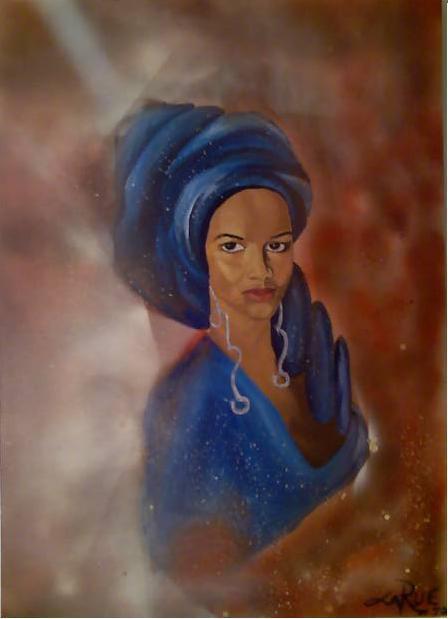
Title: Maya
Artist: Aaron Mccoy <I am trying to find out his space>
Prior post
https://aalbc.com/tc/profile/6477-richardmurray/?status=1920&type=status
Artist post
https://aalbc.com/tc/search/?q=aaron mccoy&quick=1&type=core_statuses_status
-
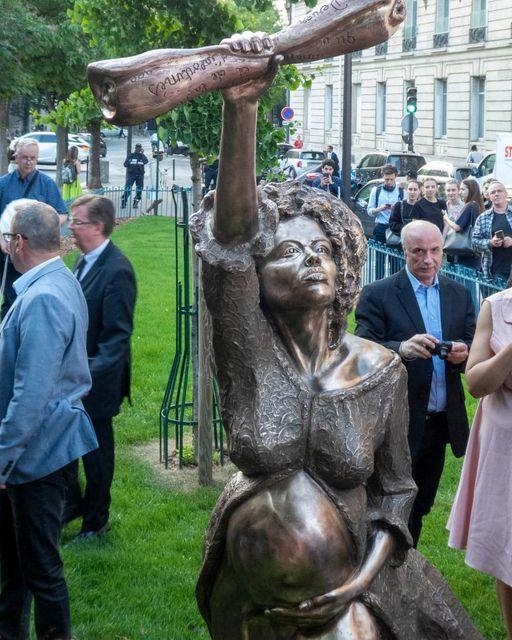
Title: Solitude
Artist: Didier Audrat.
Photographer: Entrée to Black Paris
“ Sculpture of Solitude Unveiled
Yesterday, a bronze sculpture of Solitude - the Guadelopean woman who was hanged for her part in resisting the reinstatement of slavery in Guadeloupe the day after giving birth - was unveiled in a moving ceremony at Place du Général Catroux in the 17th arrondissement. The sculpture can be found in the Solitude garden at the northernmost lawn of the square.”
Solitude unveiled
Image by Entrée to Black Paris -
Black American Millionaires
My comments in the post
@Delano black people with money have existed in the usa when it was colonies of the british empire. Black people with money are not more profitable than white people with money but have slowly grown , without enslaving or murdering other peoples for their land.
The question is, is the goal of the black community ins the usa to have communal strength or to be a collection of individuals?
@Delano for the record, I am not opposing the Black community in the USA , not the world or another country but the USA , being a set of individuals. But the only problem is, a community of individuals can't then ask/demand for collective or communal strength.
@Delano well, I said ask/demand. The point is not about weakness or strength but strategy.
I think history shows from frederick Douglass to today, the Black community in the usa is led by leaders who want to be nonviolent or positively integrate to nonblacks. They guided the black community in the usa to be a community of individuals. the problem is, most black people in the usa did and do not want that and moreover, have not handled what that means.
@ProfD one question, can you describe what a liberated black people in the usa look like? I am not refuting your statement, about what will not influence liberation for black people in the usa, but how do you define said liberation? Note I am not asking about the process or the path, I am asking about how you define the end.
@Delano yes, the old saying, strong people lead themselves... history proves that isn't a lie but isn't the truth either.
A person can lead themselves and be strong and not help their own community, especially in the usa. I think many black people have been strong in the usa post war between the states, they have led themselves to individual profit. Now does that mean the black community has improved since the war between the states, well...
@ProfD I quote you
If that is the destination, I will firmly say that can't happen in the usa for the black community, can it? complete autonomy or self sufficiency, in the usa for the black community demands black people control natural resources and have the militaristic means to defend said resources. Can that actually happen in the usa ? In another country, especially a black one, meaning has mostly black people in it, possibilities exist. but in the usa, this can't happen right?
I may comprehend you wrong, but I don't see that level of autonomy of self sufficiency for the black community in the usa. where am I miscomprehending you?
@Mel Hopkins the black community in the usa has changed right? it has gone through multiple phases since the end of the war between the states right? the modern black community has more members with a multiphenotypical background, has more members from a recent immigration standpoint, these factors are huge. the black community in the usa in the 1960s didn't have so many recent immigrants from the islands/africa/asia/south america/europe as today. and the black community circa 1865 was the most monolithic culturally/financially/heritagewise than ever after. I think the demography of the black community has changed alot in a relative short time. And I want to add having friends who came as children to the usa from places in africa, clan members who saw how black people immigrating from the caribbean were treated in the black community in the early 1900s , that the black community in the usa was forced to accept alot of new members without its want, to be blunt. Look at the white community in the usa. Even though white jews or catholics have been in the usa from the 13 colonies era, it took a very long time for the white protestants to truly embrace white jews or white catholics. Whereas in the black community, the impotency of the black community meant new black folk from latin america, from africa, from asia, had no communal restriction from Black DOSers anywhere near what white protestants gave white jews or catholics. So I concur about new ways but the black community in the usa hasn't had time to settle as a community since the war between the states and that can be problematic when you are trying to organize.
@ProfD yes, and you answered perfectly, My reply is not a condemnation of your answer, which you seem to suggest. TO a country like Nigeria or Jamaica I have nothing to say about your definition of the goal. BUT, the USA is not Nigeria or Jamaica.
I am not dissecting your definition. I am not debating if it can be applied. I am debating one thing, if it can be applied in the usa. . I think it is fair to ask can that destination be achieved in a country like the usa that is not only black people. What about the native american? based on how you define the goal for black people in the usa, if the native american wants the same freedom and whites want the same freedom <which of course they do > then all of these peoples can't have the same goal in one space. I am not talking about process but the ability of the usa as a multiracial society to provide freedoms for all its races.
I argue, the usa can't allow all races to have freedom as you define freedom for the black community. That isn't an insult to your point merely a continuation of discussion
I apologize, if I poorly move on to my centerpoint of discussion
@Mel Hopkins I again, communicate poorly, my point isn't that strong people lead themselves. I agree partially to @Delano because, one can thrive and their community not thrive. I think the black community in the usa is exhibit A of a community where individuals thrive but the community rottens. from the end of the war between the states to today, it can be argued, black individuals have thrived as presidents/supreme court jusitces, billionaires, millionaires, but the black communities black churches/historical black colleges, negro leagues, institutions are clearly less than in the past, the nation of islam as well..., every single black organization gets weaker over time in the usa not stronger. so... the strong individuals, if you judge strength by financial success or position in government, are leading themselves, but that is not making a great black community in the usa.
I communicated very poorly again, I have learned through personal experience , that no heritage ever dies, it becomes small somestimes, sometimes it becomes really large, but it never dies completely. My point is that the black community in the usa since the war between the states has never been able to settle itself and thus through white negative influence <reconstruction/kkk/jim crow/big city governments during white flight> or constant new groups of black people coming in everywhere <from jamaica/haiti/trinidad/nigeria/ghana/south africa/various places in europe/various places in south america/ various places in asia> the black community in the past or now doesn't have enough time to find a center, cause new black groups or new white negative influences are always coming. The DOSers dislike of so many Black modern immigrant groups, or vice versa, is my proof.
@Mel Hopkinsisntitutions are the symbols of a communities strength.
As a computer engineer I have experience with peer to peer networks, peer to peer networks by default are individual collections. They are very loose and while they can create in a quick amount of time utility their great weakness is the lack of a center. Which is the symbol of community.
Black is a phenotypical race, not an ancestry race, like german american, but you are correct in population numbers. it is racially fair to compare to black americans to white americans but ok.
Mel I comprehend the strategy you refer to. Maybe you think I don't. You or @Delano I don't think comprehend my point. I think the black community in the usa at the time of the war between the states was being led by black leaders to be what it is now. That was why Frederick Douglass pushed for black integration to whites. You speak of enslaved africans but frederick douglass despised the back to africa movement or even black people leaving the usa. His viewpoint is what you consider modern. I think if you back track my comments in this group they will confirm I have said this many times. but the end result of that, can not deliver a collective freedom for a majority of black people in the usa. And I must add, black communities in different countries have different situations. the usa is not the place for the kind of communalism that many black people in the usa clearly want or need. I am not knocking your stated strategy but I am opposing the idea that said strategy is an improvement as much as an eventuality based on the history of the black community.
-
MY THOUGHTS
The largest tragedy to the Black community in the USA is the purpose of its posture. Here is a community whose majority has never been happy in nor desired to be a part of the USA. But said majority never had a leadership that reflected its true desire. Instead the leadership of the Black community in the USA never wholly committed to a positive functional communal Black agenda, while promoting a dysfunctional neutral individual Black agenda. The Black community in the USA is led by a majority seeking individual treasures, while the body is a majority wanting communal empowerment. At this moment, the Black body has been sacrificed for the Black selfish minority. Shame on the Black community in the USA for not doing anything about that.
ARTICLE CONTENT
Family awarded $1.5M after inmate dies by suicide, buried at prison without their knowledge
By Dean Meminger The Bronx
PUBLISHED 9:15 PM ET May. 10, 2022The funeral for Lonnie Hamilton happened six months after he died. He was buried in 2016.
That's because when the 22-year-old died by suicide in a state prison near Syracuse, no one told his family in the Bronx.
"Ultimately buried him up at the Marcy Correctional Facility without letting anybody know," said attorney Zachary Giampa.
The Hamilton family found out two months after the fact. They eventually had his body exhumed to hold their own funeral.
Now, six years later, a state judge awarded Lonnie Hamilton's family $1.5 million.
Judge Francis Collins ruled New York State Corrections and Community Supervision, which runs state prisons, and the Office of Mental Health were negligent in Hamilton's death and didn't afford his family a proper funeral.
In his decision, the judge pointed out that Hamilton's prison record "describes an individual who needs or may need psychiatric treatment for a major mental disorder and requires housing in a facility with full-time OHM (office of mental health) staff."
Hamilton was sentenced to two-to-six years for a robbery. When he died, he was in the special housing unit at Marcy Correctional Facility in solitary confinement. Other inmates testified he was being mistreated and threatened to kill himself and corrections officers encouraged him to do it.
One former inmate, who didn't want to give his name told NY1 what he heard corrections officers say.
“’Save your breath, ain't you going to kill yourself,’” recalled the former inmate. “They kept telling him, ‘Ain't you going to kill yourself.’”
"That was corroborated with two other individuals that were incarcerated and in cells next to him who testified to that same exact fact," said family attorney Zachary Giampa. "About five other individuals providing written statements all saying the same thing."
Court documents say the same week he killed himself he was taken off of suicide watch by mental health workers. Just minutes before he hung himself with a sheet, a corrections officer reported seeing him standing on his prison bed, but didn't tell him to get down. The judge found plenty of documentation that Hamilton was a threat to himself and wrote in his decision, "Lonnie previously attempted suicide by hanging and felt he had 'nothing' to look forward to."
His family hadn't spoken to Hamilton in a few months and when they did a prisoner search online on the state's corrections website, they were stunned it said the 22-year-old was deceased.
Prison officials say they could not locate his family, despite his family still living at the same address where Hamilton was arrested. They're outraged that no one was fired for his death.
In reference to the court ruling in favor of the Hamilton family, the state's corrections department said in a statement, "The decision, which involves both the Department of Corrections and Community Supervision and the Office of Mental Health is being reviewed."
The family now has a federal court case against individual corrections officers for violating the constitutional rights of the 22-year-old.
What You Need To Know
Records show Lonnie Hamilton tried to commit suicide several timesHis family believes corrections officers tried to cover up their son's mistreatment and death
Twenty-seven percent of 31,000 prisoners in state custody are being treated for mental illness
Advocates say it's not just Rikers and city jails, but state prisons have lots of issues as well
ARTICLE URL
-

Loctecks Coloring book: A Diverse Japanese Anime/Manga Inspired Coloring Pages for Kids, Teens, Adults, and Artist Paperback – April 4, 2022
Selling book
https://www.am*zon.com/dp/B09X3JYM32/ref=cm_sw_r_apan_i_2F5RKEZ09BT129AGFQ00
referred by DJDONTTOUCHTHETREM
https://www.deviantart.com/djdonttouchthetrim/art/Black-Girl-Magic-915714270 -

EVOLVE isn't aiming to be a large agency. Osaka's agent, Stuart Duguid, who also left IMG for Evolve, said the company may only take on one or two other athletes. Duguid explained the business is mostly about "building Naomi’s business from $50 million a year to $150 million a year."
ARTICLE
UNCONFIRMED
Of the top 100 athletes only two are women.
First is NAomi Osaka and second is Serena Williams
Top 100 Highest-Paid Athletes in the World 2022 – Sportico.com
-
Title: Space Possum
Artist: GDBee < https://gdbee.store/ >
prior entry
https://aalbc.com/tc/profile/6477-richardmurray/?status=1912&type=status
GDBee entries
https://aalbc.com/tc/search/?q=gdbee&quick=1&type=core_statuses_status
-

Title: Office Assistant
Artist: GDBee < https://gdbee.store/ >
prior entry
https://aalbc.com/tc/profile/6477-richardmurray/?status=1911&type=status
GDBee entries
https://aalbc.com/tc/search/?q=gdbee&quick=1&type=core_statuses_status
-

Title: Killer Whale Mermay
Artist: GDBee < https://gdbee.store/ >
prior entry
https://aalbc.com/tc/profile/6477-richardmurray/?status=1910&type=status
GDBee entries
https://aalbc.com/tc/search/?q=gdbee&quick=1&type=core_statuses_status -

Title: Camo x Flowers
Artist: GDBee < https://gdbee.store/ >
prior entry
https://aalbc.com/tc/profile/6477-richardmurray/?status=1909&type=status
GDBee entries
https://aalbc.com/tc/search/?q=gdbee&quick=1&type=core_statuses_status -
Title: Tea Collection
Artist: GDBee < https://gdbee.store/ >
prior entry
https://aalbc.com/tc/profile/6477-richardmurray/?status=1908&type=status
GDBee entries
https://aalbc.com/tc/search/?q=gdbee&quick=1&type=core_statuses_status






